Concern over threatened and endangered tonewood species is nothing new. For nearly as long as there has been worry over forest conservation, players and builders have wondered about the guitar’s place in the puzzle. But conversation about the problem is evolving in ways experts might not have foreseen only a decade ago.
Until recently, talk of the future of tonewoods typically followed two threads: How much rosewood, mahogany, ebony, spruce, ash, and other woods were left in the world? And what would replace those woods when supplies grew too thin? Both questions address valid concerns. But the failure to consider wider, more complex factors led to a lot of binary, zero-sum thinking about the issue. As a result, many observers peddled grim scenarios where the finest wood would disappear while acoustic guitar quality steadily went to pot.
In fact, the real state of tonewoods is a multifaceted, labyrinthine, and fluid problem. The solution to supply problems and scarcity is not always a simple exchange of a classic threatened wood for a temporarily less-endangered one. Instead, guitar consumers, players, and builders are confronting a fast-evolving, intricate, and ever-changing wood supply chain—one where everything from political unrest, climate change, pests, and even the decades-old decisions of urban landscapers will shape the wood sourcing landscape. “There is a time and place for alternative woods,” says Scott Paul, an environmental advocate and director of natural resource sustainability at Taylor Guitars. “But you have to think things through a great deal when it comes to your sources. And you have to address methods of consumption rather than just shift it from one region to another.”
In some respects, the situation is chaotic. But information about the subject is also more abundant and easier to share than ever. That’s leading to better, more responsive management of resources, greater communication among builders, and in many cases, excellent instruments built from unconventional woods that may become classics in their own right.
The evolving tonewood situation demands that consumers and builders will need to be honest and informed about changes in the market. Players need to be more aware of wood myths, and alert to shifting market conditions down to the local and community level. Most importantly, they will have to be open-minded to the possibility that great guitars can come from woods other than Brazilian rosewood, Honduran mahogany, and Adirondack spruce. When they do, they will discover instruments that deliver many aesthetic and sonic surprises.
Earthly Concerns
That the acoustic guitar should become a bellwether of wood scarcity is a bit of cruel irony. After all, the steel-string flattop is arguably the guitar’s earthiest expression—an embodiment of bucolic and folksy imagery that spans beach fires, Neil Young ranch jams, Maybelle Carter’s revolutionary scratch, and Bert Jansch’s solitary picking in a bohemian bedsit.
But however powerfully these scenes evoke down-home, carbon-neutral, and downright organic modes of creative expression, the fact is, acoustic guitars exact a cost to the environment—primarily because because many prized instruments use tropical hardwoods like rosewood, mahogany, and ebony that, since colonial times, were harvested with little regard for wider ecosystem health.
Many of these species remain vulnerable. Brazilian rosewood—the source of back and sides on golden-age Martin D-28s, OM-28s, D-45s and others—is threatened by habitat loss and slow regeneration rates. Honduran mahogany, which makes up the backs and sides of classic Gibson J-45s and Martin D-18s, has seen dramatic habitat loss from clear cutting. Even Adirondack spruce and Sitka spruce, North American trees with populations that have stabilized, have seen mature and old-growth populations that sustain healthy ecosystems and help new growth thrive, clear cut to disastrous effect.
Photo 1: Santa Cruz Guitars’ Richard Hoover loves the possibilities of reclaimed redwood: “We’re still at a point where we don’t have to cut a tree to get really nice stuff.” Photo by Carolyn Sills
The electric guitar industry has been profoundly affected too, as Fender’s recent retreat from swamp ash and switch from rosewood to pau ferro fretboards on affordable guitars illustrates. And though guitars make up a small fraction of the lumber consumption that threatens certain species, the instruments are what Scott Paul calls “canaries in the coal mine”—offering early, but very visible hints at the decline of certain forests.
The good news is that much of the guitar industry has their eyes wide open to the problem. Many builders have foresight, ethical bearing, and business sense enough to know that without good wood, they might as well be making badminton rackets. That awareness makes modern builders a resourceful lot. And the tonewood crisis is sparking exploration of new species, reclamation efforts, and repurposing of trees that would’ve never been considered for tonewood just a few years ago. It’s also encouraging flexible and community-engaged, smart-cultivation techniques—some of which could drive recovery for species we thought would be off the tonewood menu for good.
Amid all these challenges, builders are applying the sum of their knowledge to craft guitars that rival golden-era flattops for sound and quality. As Paul says, “We’re at an inflection point in the history of musical instrument manufacturing. The industry has really been doing things a certain way for 200 years and we’re at the precipice of having to adapt.”
Photo 2: West Coast Arborists are working with Taylor Guitars to supply Shamel ash from reclaimed Los Angeles street trees. Photo by Micah Sidmak — courtesy of Taylor Guitars
Adaptation Is Industry Tradition
Acoustic guitar historians should be receptive to adaptation. After all, many tonewoods we regard as classic were used simply because they were what was around at the time. From Spanish flamenco guitar builders that used the cypress in their backyards to Leo Fender sourcing ash and alder from furniture builders down the street, guitar luthiers have always used local wood or what was easiest and cheapest to source at the time.
Some such success stories are happy accidents, of course. Not every local tree is suited for guitar building. And for all the same reasons that prized tonewoods are scarce, there aren’t a lot of cabinetry shops sitting on a surplus of ash and eager to dump it on the cheap these days. But for all these problems, the tonewood industry is better networked and informed than ever, and its wood-sourcing options are broader and more diverse.
Given all this knowledge, why has adaptation in the guitar industry come so slowly? In part, it’s because navigating a constantly evolving supply situation is like a game of Whac-A-Mole. But it’s also because the acoustic guitar is burdened by a very romantic history that’s peppered liberally with myth—particularly when it comes to hallowed species like Brazilian rosewood that make up so many golden-era instruments.
Photo 3: Shamel ash is already used for the backs and sides of Taylor’s 324ce. Bob Taylor likens its properties to ’60s pattern-grain Honduran mahogany. Photo by Taylor Guitars
Objects of Desire
Any luthier will tell you, there is no denying the beauty of Brazilian rosewood. Quartersawn backs and sides have deep, straight grain, while slab-cut sections have an almost psychedelic, many-hued swirl. As beautiful as it looks, it sounds even better: responsive, clear in the low end, and snappy and bell-like in the treble range. Brazilian rosewood even smells intoxicating. In fact, its oil was once a common ingredient in perfume making.
Like so many woods, Brazilian rosewood’s most spectacularly grained specimens come from old-growth trees. But taking big, old-growth trees before they’ve reached the end of their life span is incredibly destructive to the ecosystems that grow up in their shadows, and mismanagement of these ecosystems can cause more severe, widespread environmental problems and global-scale ripple effects.
Brazilian rosewood was the subject of forest-management problems as far back as the 1960s, when Brazil prohibited un-milled rosewood from leaving the country. When American guitar makers grew dissatisfied with the decreasing quality of the Brazilian rosewood they could get, they looked for alternatives. By 1969, Martin pivoted to use of Indian rosewood. The price of older Brazilian rosewood guitars soared, and it became, arguably, the first coveted celebrity tonewood. Sadly, it would not be the last.
Ongoing Obstacles
The challenges that made Brazilian rosewood scarce have not abated. And while international regulatory bodies like CITES and laws like the Lacey Act help protect many threatened species, problems have worsened or persisted in just about every ecosystem where tropical hardwood is harvested—particularly when political turmoil muddles the picture.
“The part of the world I’m most concerned about is the Congo Basin,” says Paul. “Because that’s the last frontier in terms of Wild-West-style resource grabbing and the rule of law is not always strong.” Illegal harvesting and corrupt political systems that look the other way aren’t the only problems either. A lot of old growth is lost when forest acreage is converted to crops and livestock pasture that can be more profitable in the short term.
Then there’s those tonewood myths, and the problems of marketing and consumer bias. For decades new guitar manufacturers and and vintage-guitar enthusiasts hyped the sacred status of species like Brazilian rosewood. But they also created many false impressions around irreplaceability in the process—like the notion that nothing could ever sound as good as a Brazilian rosewood-backed flattop—that are now hard to shake.
“When we started, if we didn’t make a guitar that looked like an old rosewood Martin or a mahogany Gibson, we would never have had a chance,” says Richard Hoover recalling his early days as the founder of Santa Cruz Guitar Company. “When we started working with koa as a mahogany alternative back in the 1970s, that was really hard to do. Even though it has very similar tone to mahogany, it has this really spectacular and different visual presence that isn’t at all like mahogany,” Hoover continues. “That made koa a hard sell, even though the guitar sounded great and looked fantastic. When Martin and Taylor got into koa, that made things easier. But early on, it was a struggle to overcome the appeal of tradition.”
Even now, for a thoroughly modern acoustic guitar company like Taylor that makes alternative tonewoods a feature attraction, the allure of marquee, classic tonewoods can be tough to overcome. “There’s no doubt a rosewood guitar sells faster,” says Taylor Guitars founder Bob Taylor. “That brand recognition still exists, and some woods are still hard to sell—not because they don’t sound great—but because it comes down to marketing.”
A Path Through the Trees
Needless to say, the tapestry of challenges facing manufacturers trying to do the right thing can look hopelessly knotted. But some of the most important revelations about tonewood—and the best chances for species restoration and sustainability—are rooted in that complexity. Builders now find that solutions that appear simple on the surface—like replacing an endangered species with another ostensibly less-endangered species—don’t accomplish much if the replacement wood suffers from mismanagement or its own ecosystem collapse. In fact, in some regions the best solution isn’t abandonment of traditional tonewoods, but controlled, cooperative harvests and cultivation of community support that ensures survival of their larger ecosystems—people included.
Ash has been a Fender fixture since the 1950s. But the Jimmy Page Mirror Telecaster may be one of the company’s last production-line ash guitar models for the foreseeable future, and shortages mean they will only use the wood in select high-end and Custom Shop models.
Scott Paul uses small-scale community harvest of Central American mahogany as a case in point: “Old-growth mahogany has been wiped out in a lot of Central America. But in Guatemala, community forests that were given to small villages to harvest are some of the only old-growth canopy left. The rest of the land has been converted to pineapple or palm oil. So if people looking for a simple answer to the problem just say, ‘stop using mahogany,’ you’ll put those community forests in danger because they’ll cease to be sustainably profitable and productive as a canopy forest.”
“If you take that income away, the forest will be clear cut and changed over to pineapple or palm. So I get really nervous when people talk about alternative woods always being better or a single species being a more environmentally sound choice across the board. And if we turn our backs on some of the traditional species entirely, it might actually doom those ecosystems. Between the Guatemalan situation, and what we’ve seen with mahogany in Fiji, for example, there is evidence that a threatened species can thrive amid good management.”
The mahogany situation also illustrates how the state of tonewood in a given region can shift faster than the messaging that travels within the acoustic guitar community. “The mahogany you get from community harvest won’t be enough that you can industrialize it, or sell it by the shipload,” says Taylor. “But suddenly it’s easier to get sustainable mahogany than sustainable sapele, which was regarded as a mahogany alternative just a few years ago. Now, sapele is being logged in an industrial fashion in places that are often virtually lawless. That swing—where mahogany could become an environmentally friendly option—happened over 20 years. But you don’t hear much about it.” Even in an age of instant communication, word about such shifts can be hard to get out in the world.
Driving Perceptions
Continued use of sustainable mahogany and rosewood may not do much to shift marketing bias away from those woods. But it does buy time for other tonewoods to establish themselves as viable alternatives, and companies big and small are seeing increased interest from open-minded customers. Santa Cruz’s Richard Hoover says he thinks his customers—who often have classicist tendencies—are open to change. “Now that we’re established, people trust us and know now that when we do something different, it’s not because it’s a marketing move or driven by a need to come up with something new every six months. If we build a guitar, it’s because it has real potential as an instrument.” Hoover also realizes more education about tonewood history can help shift emphasis in the stories the guitar industry tells. “Wood alternatives are an old idea,” he says. “Not many people know that in the 1920s, Martin made instruments like the 0-28K—a koa-top guitar that sounded awesome. So there’s a precedent for these alternatives being classics.”
The spectacular figuring of the Brazilian rosewood—and its even more spectacular acoustic qualities—help make this pre-war Martin D-45 one of the most desirable vintage Martins. Photos Courtesy of C.F. Martin Archives
Taylor Guitars designer and partner Andy Powers also thinks time and history are on the guitar maker’s side. “The expectations of what a guitar looks and sounds like should be respected,” Powers says. “I don’t want the changes we make to be jarring for the player. But slow shifts in standards are part of guitar history. Look at the Fender Stratocaster. In 1954, that would’ve been a pretty wild-looking guitar. Now it’s an icon. Sometimes these things take time.”
On the electric side, too, manufacturers are taking pride in historical adaptations that purists once viewed skeptically. “Leo Fender used what was at hand and available,” says Fender executive vice president Justin Norvell. “So in the old days you saw Fenders in everything—pine to sassafras to ash to alder. We don’t take the decisions to switch woods lightly, but there is historical precedent for messing with the recipe.”
A More Enlightened Harvest
Guitar builders, governments, and communities can do much to rectify the problems facing tonewood supplies. The most important shift in the dynamic between suppliers and players will come when the latter opens up to the potential of non-classic woods. That won’t be easy in a guitar-media environment that constantly celebrates the virtues of vintage instruments and the celebrity players who own them. Then again, the first instruments built in response to the early days of the tonewood crisis are now becoming vintage instruments and coveted in their own right. It will be interesting to see how these guitars, built around alternative tonewoods, work their way into the classic acoustic guitar pantheon in the years to come.
Regardless of how new classics reshape the conversation about the most desirable tonewoods, the revelation most likely to drive acceptance of alternate woods and materials is that good music is made by musicians, not priceless vintage guitars locked away in cases. So the next time you get hung up on the essential nature of Brazilian rosewood, ask yourself if “Blackbird” moves you because of the makeup of Paul McCartney’s D-28 … or is it his touch as a songwriter and picker? Inspiration can come from anywhere, any guitar, and any guitar-making material. And there is no shortage of inspiration—or alternatives—out there if we’re resourceful, clever, crafty, persistent, and willing to dig to find it.
Santa Cruz Guitars’ Richard Hoover holds a spectacular redwood-topped 12-fret OOO model. Photo by Carolyn Sills
Seeking Sustainable Substitutes
The danger in thinking about alterative tonewoods is that they can look like a magic bullet when, in fact, they are rife with their own hidden problems. Savvy builders know that few woods are entirely free of ethical or supply chain complications. But they also know extraordinary instruments can come from many different woods—some of which are every bit as effective at generating great, unique tones as their more famous counterparts.Top Concerns
Top woods are, in some ways, the trickiest part of the tonewood equation. Because while good backs and sides can be built from any number of sound-reflective woods and materials, including laminates, a good top has to have a certain set of resonant and vibrational qualities.
“For a top, you need something light and strong with a good weight-to-strength ratio,” explains Richard Hoover of Santa Cruz Guitar Company. For decades, the ideal woods for the job have been North American and European spruce varieties, which are responsive, warm, clear, and structurally strong. Mahogany and koa, with their warmer, darker tonalities, also became more common top-wood options in the early 20th century. More recently, flattop builders have borrowed a page from European classical guitar builders and embraced cedar; a relatively abundant, softer wood that’s highly touch responsive, rich in overtones, and ideal for fingerstyle guitars.
But some of the most promising developments in top wood come via the use of redwood, which shares many of cedar’s tone properties and can be sourced readily through reclamation efforts. “I’m delighted with redwood as an alternative,” says Hoover. “It’s a beautiful wood and it often has a really interesting history—especially when reclamation stories are involved. Those stories help people see redwood not as a compromise but something unique. It’s getting more competitive to source, but we’re still at a point where we don’t have to cut a tree to get really nice stuff.”
Back to the Beginning
Back and side woods can be difficult to source sustainably, largely because the most treasured specimens are historically old-growth tropical hardwood. But there are many wonderful and abundant alternatives to rosewood and mahogany depending on your tone preferences. And increasingly, smart resource management is making some rosewood and mahogany species a sustainable proposition. “There’s a global crisis with rosewood—particularly in Asia and parts of the Americas,” says environmentalist Scott Paul. “But while the state of Indian rosewood could certainly be better, it’s more reliably managed and we have a handle on it.”
Mahogany, too, is recovering as a viable tonewood because of effective management—notably in Fiji where plantations established by the British more than 80 years ago have reached maturity and are carefully cultivated with the goal of sustainability. Local community management is also paying big dividends and saving old-growth canopy in Honduras, Mexico, and Guatemala.
Replacements for rosewood and mahogany can be a tough sell because of their association with prized vintage instruments. But in strictly tone terms, there are many excellent alternatives. Walnut, which combines many of the tonal attributes of rosewood and mahogany—including great bass response and bright high-end tones—is highly sustainable. Ovangkol, an African hardwood with many of the same tone properties as rosewood, is also currently abundant and in good health as a species. Koa, while less abundant, works well as a substitute for rosewood thanks to its excellent responsiveness, but can also stand in for mahogany because of its warmth. Sapele, meanwhile, remains a common mahogany replacement, but is falling out of favor in some cases because of questionable harvesting techniques.
Recently, Taylor Guitars began exploring a mahogany alternative from a most unexpected source: shamel ash that was planted as shade trees in the Los Angeles region. “Shamel ash is like the golden retriever of woods,” raves Bob Taylor. “It really reminds us a lot of ’60s pattern-grain mahogany—the mahogany you just can’t get anymore—and we’re getting it from recovered old trees at the end of their life cycle.”
Threatened wood supplies also affect the electric guitar industry—most visibly in the rosewood, mahogany, and ebony markets. But a very different kind of ash—namely the swamp ash that made so many 1950s and 1960s Telecasters sing, is now threatened by pests and climate change. In the short term, Fender is taking a page from its own history and experimenting with woods like pine as a replacement. But they’re also looking even further down the road at ways to sustainably revive ash forests that can be used in production. “We’ve found a strain of ash that’s beetle resistant, and we’re starting to plant those,” says Justin Norvell. “But that’s more of a ‘see you in 30 years’ kind of situation. It will be a while before we can touch that wood and bring that ash back into the mix.”


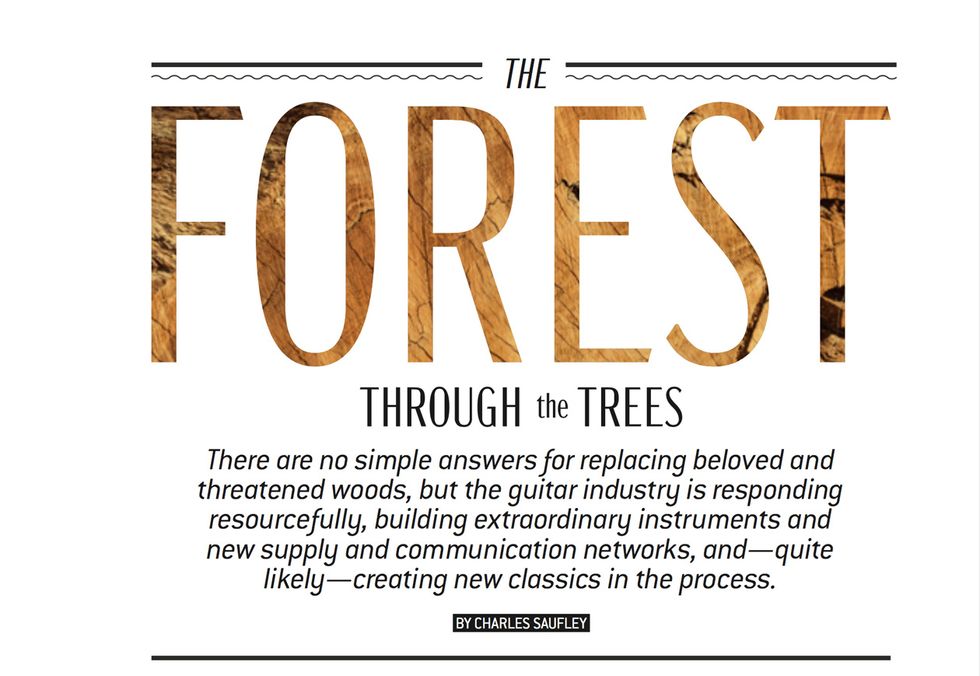

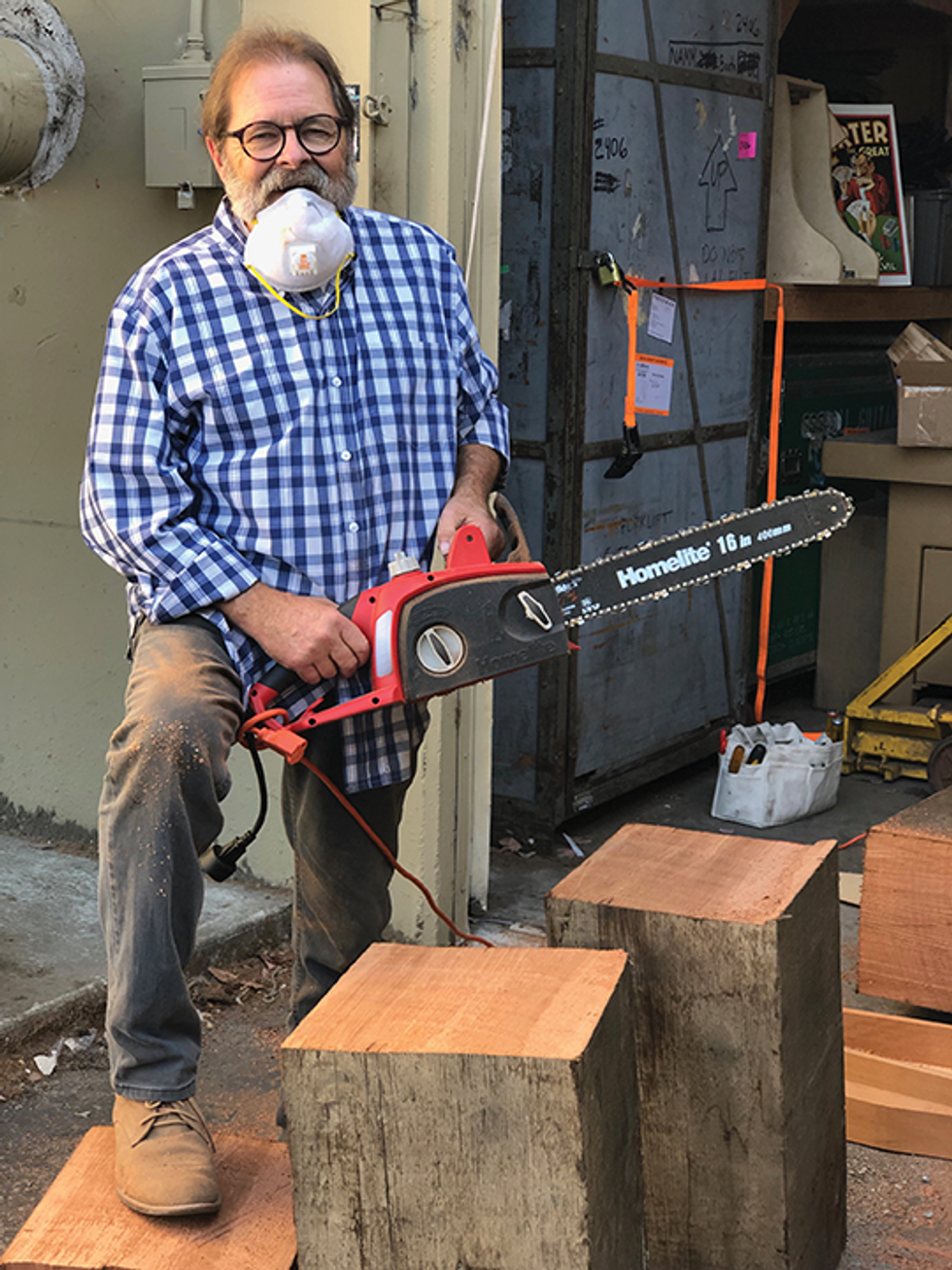
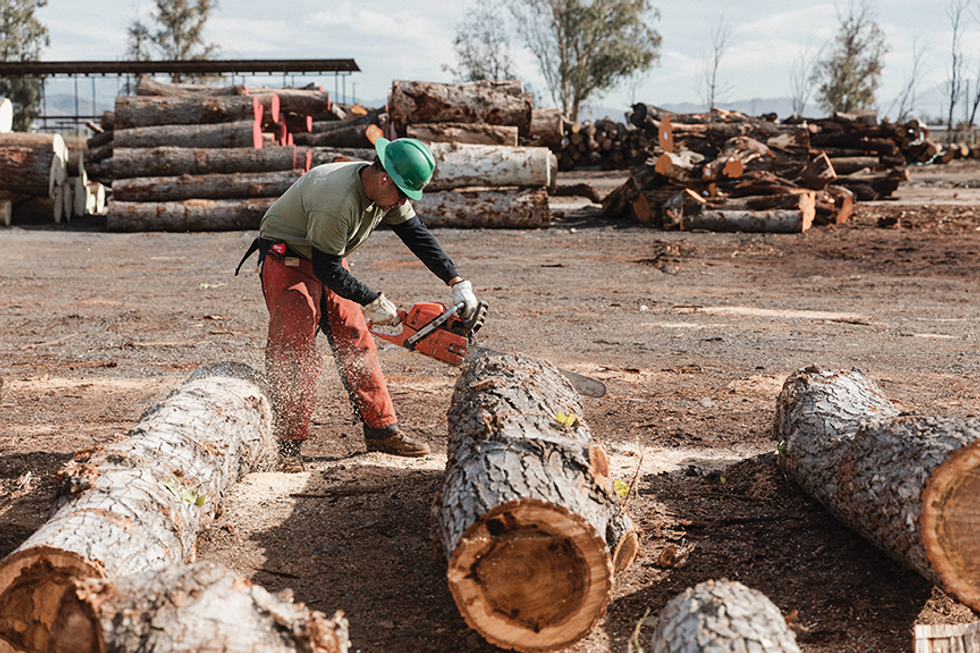
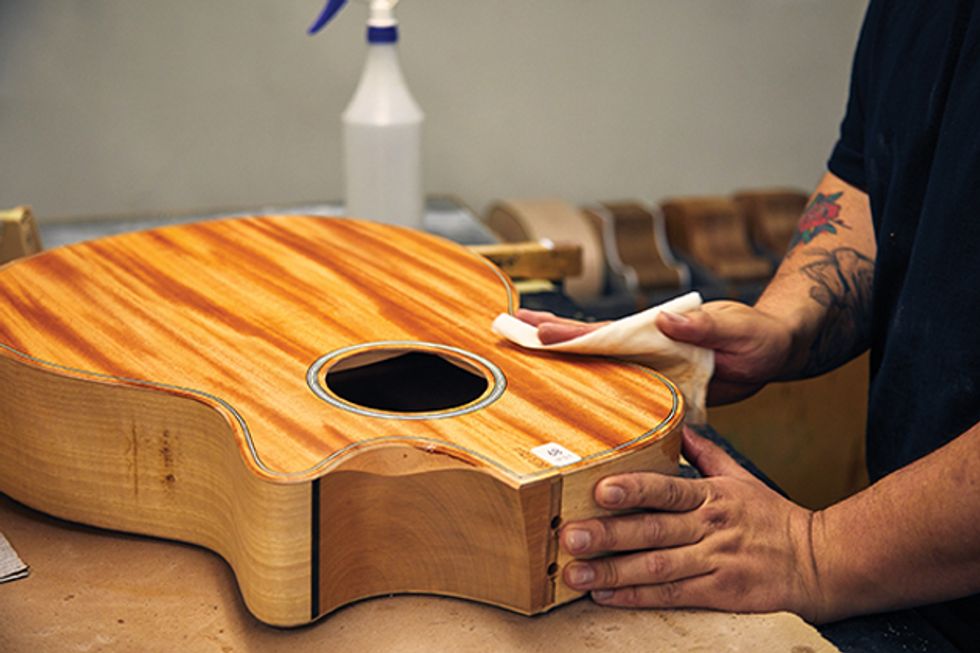
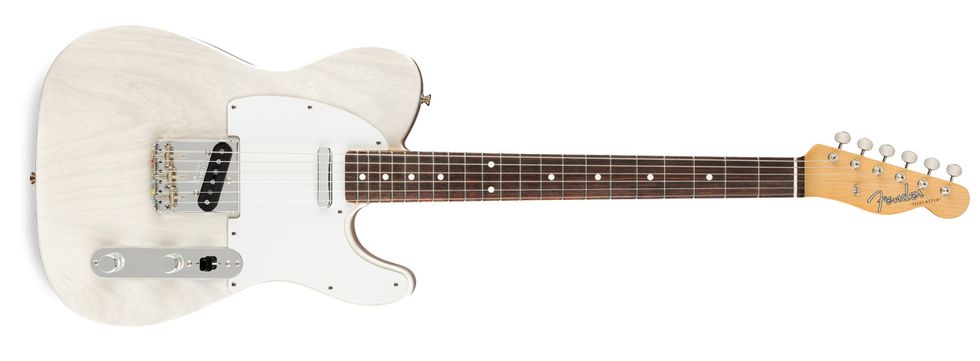
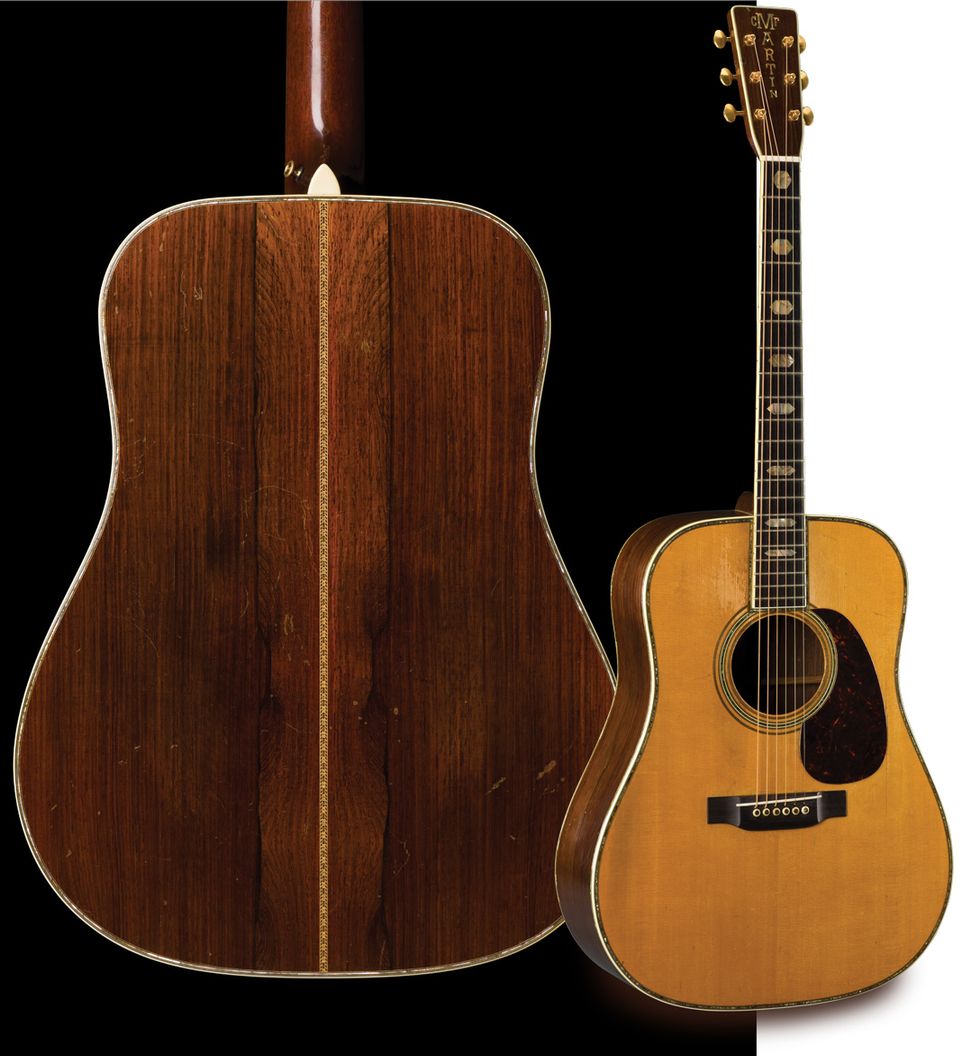











![Rig Rundown: Russian Circles’ Mike Sullivan [2025]](https://www.premierguitar.com/media-library/youtube.jpg?id=62303631&width=1245&height=700&quality=70&coordinates=0%2C0%2C0%2C0)




